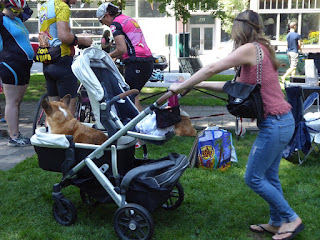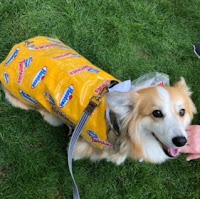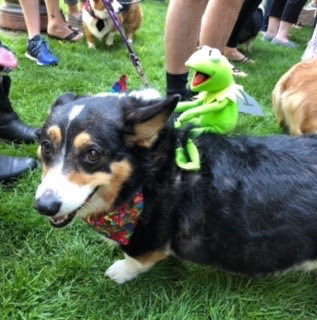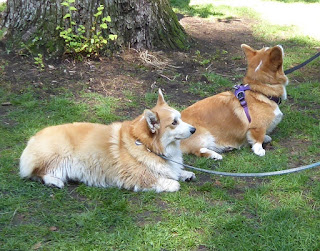 |
| Photo courtesy John Worsley, whose dogs them are |
One cold rainy spring, Dave was working a Memorial Day shut-down at a paper mill in a damp, dreary coastal Washington town, and unbeknownst to him, back in Portland it was ninety degrees and not raining for the first time since forever, and every single person in town was out soaking up every sunny minute of it, frying burgers, and slamming PBRs, and generally carrying on. And when Dave emerged from the mists and came back home, everyone on the street was burnt to a crisp. He thought there’d been a nuclear event.
It was just about that disconcerting for us last weekend to walk downtown like it was any other day and stroll into the Park Blocks. What we saw didn’t make sense. It was as though while we were sleeping everyone in town but us had been issued the top half of a dog.
 |
| Or a Corgi stroll. |
What it actually was was a Corgi Walk. There were so many people walking around with Corgis that the occasional Regular dog looked all wrong. I have always imagined Corgis were bred specifically to be visually appealing. It’s not possible to ignore a Corgi walking away from you. You might not have previously thought of yourself as a dog butt aficionado, and then those fluffy pantaloons go bopping by and it’s all over but the trip to the breeder.
I further assumed that Corgis were developed right around the time of the invention of the coffee table, when Labrador Retrievers proved to be a disaster to the onion dip.
 |
| Photo by John Worsley |
Actually, however, Corgis are no recent thing. There are two main kinds of Corgis: Cardigans and Pembrokes. Originally they were called the Cardiganshires and the Pembrokeshires, but that got shortened too, of course. The Cardigans are the older breed, having turned up in Wales as early as 1200 BC. They come in a variety of coat colors and button up the front, and they have long tails carried low, because there are no options for Corgis to carry anything high. Many of the Pembrokes have been bred to be tailless or have been whacked into that condition as puppies. Ostensibly this is to keep their tails from being stepped on by whatever they’re herding, although I suspect at this point it’s more for the fluffy bopping pantaloons effect, which is indeed compelling.
 |
| Photo by John Worsley |
Even my beloved Vikings had Corgis, as it turns out, and brought them to Wales once they’d gotten the horns bred out of them. Basically Wales has been Corgi Central since before the Romans invaded the Ordovices, and doesn’t that sound painful? And they were not bred as speed bumps or ottomans as one might expect, but as herders, first of cattle, and later of sheep. Sheep, in fact, are reliably flustered right into their pens by even the sight of those skittering tubes of fur. And if they aren’t, they are subjected to a good heel-nipping.
In fact, corgular nippage is the only plausible explanation for the recent case of a sheep falling off a mountain in Northern Ireland, because sheep are known for their grippy feet. Nevertheless one did fall some distance a few days ago, fortunately escaping serious injury by landing on a boy.
 |
| Sit? |
So Corgis are durable and healthy dogs. Even the scourge of hip dysplasia is unknown among Corgis because they do not have actual hips, but just a toe assemblage on a stout stem at each corner. They had become something of a rarity until Queen Elizabeth took a fancy to them. She was presented with her first Corgi in 1933. His name was Dookie, and why not?
Nowadays they are enjoying renewed popularity, as evidenced by the Corgi Walk. They are friendly and loyal and have a reputation for being easy to train. You tell a Corgi to Sit and it does. Or we think it does. It’s hard to tell.
Too cute, your written piece and these dogs. You are oh so right about Lab tails being lethal.
Our cat Tater has a very similar tail, with similar capabilities.
I like a fluffy butt as much as the next person, but Corgis never did much for me. I don't doubt their enthusiastic fans because I know a few, but I just don't get it. I did once have a malamute that could shame a lab with his table clearing tail abilities.
I think I appreciate them because I'm not that into real small dogs but these have full size heads and real ears and real snouts. Also, long legs aren't everything, or I'm in a heap of trouble.
We have a West Highland White Terrier, which is built much like a Corgi but better. She’s pearly, funny, smart, and she smells good naturally. And so cute, I have puppy-proofed my house for her by putting up baby gates on all the rooms where she feels compelled to chew up the decor. This has resulted in a bad case of hip displaysia from launching myself over the gates with my hands full of laundry or cleaning apparati. It’s stupid the stuff we’ll go through for fluffy pantaloon butts and nose kissies.
Ah. They never tested us for dysplasia when we were puppies–I guess you're stuck.
I am with Jono. Corgis are ok I guess, but I much prefer bigger dogs. And remember a German Shepherd tail which was a table clearer. I suggested that my mother used her to dust, but she smiled and gave the duster to me – and took the dog outside.
Hmm. You might have just solved something for me. I've had trouble getting the dust on the inside of my piano. Maybe I should spray a hamster with Endust and shut the lid on it for a while.
They are super cute (& so are your posts)!!
My posts are short too!
And here I thought you were going to write about cat hairballs, which tend to be tubular, at least in our house. Corgis are much better than hairballs, even though they wouldn't be my choice of pet. But I will ever after think of them as "the top half of a dog"! Thanks for the smiles.
Okay, here's another Tater The Cat fact. Not only does she have a Labrador Retriever tail but she has never horked up a hairball in her life. We already refer to her as "the dog."
I've never actually met a corgi, although I've seen a few from a distance. I thought you were gong to write about cat hairballs too.
I wonder if there's a blog post in that.
You have a true gift for painting gorgeous verbal pictures!
Thanks! It's easier than watercolor.